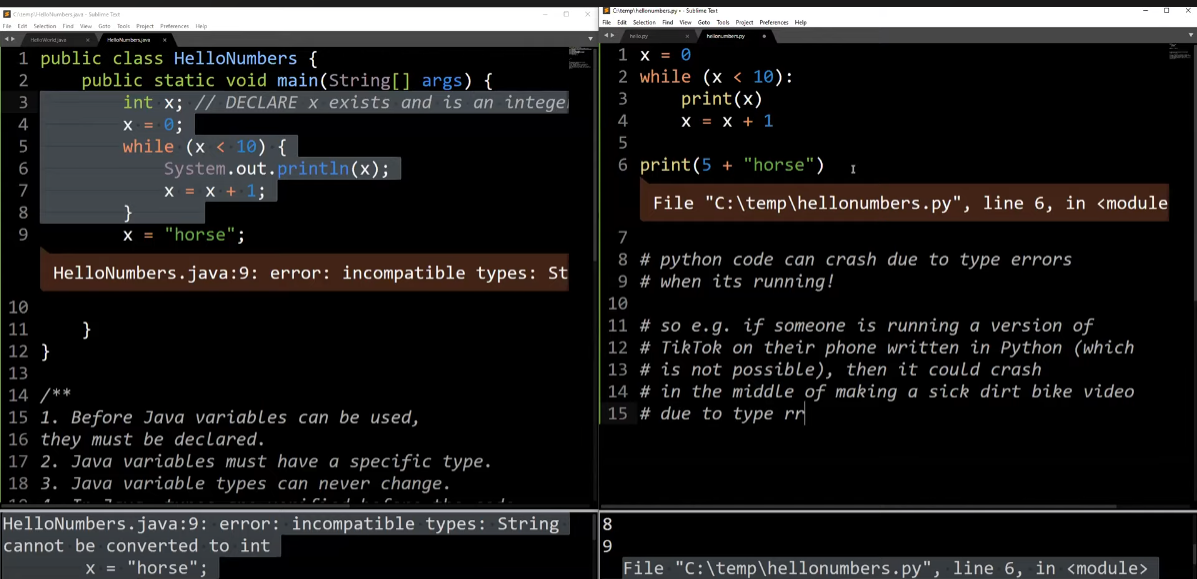Java is an object-oriented language with strict requirements:
- Every Java file must contain a class declaration
- This is not completely true, e.g. we can also declare “interfaces” in .java files that may contain code
- All code lives inside a class*, even helper functions(all functions in Java are methods), global constants, etc.
- To run a Java program, you typically define a main method using
public static void main(String[] args) - Other syntax:
- All statements in Java must end in a semi-colon.
- We delimit the beginning and end of segments of code with
{ };
Java is statically typed:
- All variables, parameters, and methods must have a declared type.
- That type can never change.
- Expressions also have a type, e.g.
larger(5, 10) + 3has typeint. - The compiler checks that all the types in your program are compatible before the program ever runs
- e.g.
String x = larger(5, 10) + 3will fail to compile. - The compiler ensures type consistency. If types are inconsistent, the program will not compile.
- This is unlike a language like Python, where type checks are performed DURING execution.
- e.g.
Differences between dynamic typing and static typing:
- Dynamically-typed languages perform type checking at runtime, while statically typed languages perform type checking at compile time.
- Statically-typed languages require you to declare the data types of your variables before you use them, while dynamically-typed languages do not.

Client Programs and Main Methods. A Java program without a main method cannot be run directly using the java command. However, its methods can still be invoked using the main method of another class.
Class Declaration. Java classes can contain methods and/or variables. We say that such methods and variables are “members” of the class. Members can be instance members or static members. Static members are declared with the static keyword. Instance members are any members without the static keyword.
Static vs. Instance methods. The distinction between static and instance methods is incredibly important. Instance methods are actions that can only be taken by an instance of the class (i.e. a specific object), whereas static methods are taken by the class itself. An instance method is invoked using a reference to a specific instance, e.g. d.bark(), whereas static methods should be invoked using the class name, e.g. Math.sqrt(). Know when to use each.
The this keyword. Inside a method, we can use the this keyword to refer to the current instance. This is equivalent to self in Python.
Comparison of Java and Python/C:
| Java | Python | C |
|---|---|---|
| high level | high level | middle level, because binding of the gaps takes place between machine level language and high-level languages. |
| Compiled programming Language | Interpreted programming language | Compiled Language |
| Platform-unaffected | Platform independent | Platform-specific |
| Object-oriented programming | Object-oriented programming | Procedural Programming |
| Syntax rules are strictly followed. | It isn’t necessary to use semicolon. | Syntax rules are strictly followed. |
| statements are grouped by braces | statements are grouped by indentation | statements are grouped by braces |
| static typing | dynamic typing | static typing |
| fast | slower | faster |
| it uses automatic memory allocation. | ——————- | Memory allocation can be done by malloc in C |
| It doesn’t offer control over garbage collection | ——————- | It offers control over garbage collection, like free() |
| It doesn’t support pointers | It doesn’t support pointers | It supports pointers |